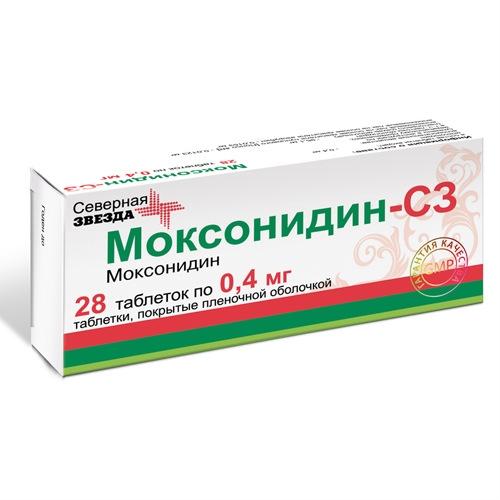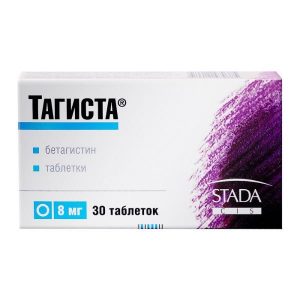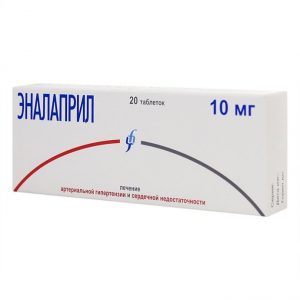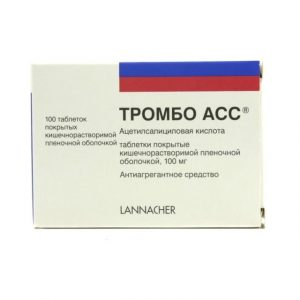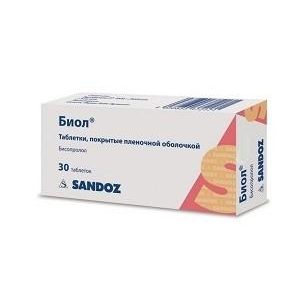Description
Release form
Tablets.
Packing
28 pcs.
Pharmacological action
Pharmacotherapeutic group of the drug: Central antihypertensive.
ATX code: [ ¡02 ¡05]
Pharmacodynamics
Moxonidine is a hypotensive drug with a central mechanism of action. In the brain stem structures (the rostral layer of the lateral ventricles), moxonidine selectively stimulates the imidazoline-sensitive receptors involved in the tonic and reflex regulation of the sympathetic nervous system. Stimulation of imidazoline receptors reduces peripheral sympathetic activity and blood pressure (BP). Moxonidine differs from other sympatholytic antihypertensive agents in a lower affinity for β2-adrenergic receptors, which explains the lower likelihood of developing a sedative effect and dry mouth. The use of moxonidine leads to a decrease in systemic vascular resistance and blood pressure. Moxonidine improves the insulin sensitivity index (compared with placebo) by 21% in patients with obesity, insulin resistance and moderate arterial hypertension. Pharmacokinetics
Absorption:
After oral administration, moxonidine is rapidly and almost completely absorbed in the upper gastrointestinal tract. Absolute bioavailability is approximately 88%. The time to reach maximum concentration is about 1 hour. Eating does not affect the pharmacokinetics of the drug.
Distribution of
Communication with plasma proteins is 7.2%.
Metabolism
The main metabolite is dehydrogenated moxonidine. The pharmacodynamic activity of dehydrogenated moxonidine is about 10% compared with moxonidine. Withdrawal The half-life (T1 / 2) of moxonidine and the metabolite is 2.5 and 5 hours, respectively. Within 24 hours, over 90% of moxonidine is excreted by the kidneys (about 78% unchanged and 13% in the form of dehydri-romoxonidine, other metabolites in the urine do not exceed 8% of the dose). Less than 1% of the dose is excreted through the intestines.
Pharmacokinetics in patients with arterial hypertension: Compared with healthy volunteers, patients with arterial hypertension did not show any pharmacokinetic changes in moxonidine.
Pharmacokinetics in the elderly
Clinically insignificant changes in the pharmacokinetic parameters of moxonidine in elderly patients have been noted, probably due to a decrease in the intensity of its metabolism and / or slightly higher bioavailability.
Pharmacokinetics in children
Moxonidine is not recommended for use in patients under 18 years of age, and therefore pharmacokinetic studies have not been conducted in this group. Pharmacokinetics in renal failure
Excretion of moxonidine is significantly correlated with creatinine clearance (CC). In patients with moderate renal failure (CC in the range of 30-60 ml / min), the equilibrium plasma concentrations and final T1 / 2 are approximately 2 and l, 5 times higher than in patients with normal renal function (CC more than 90 ml / min.). In patients with severe renal failure (CC less than 30 ml / min.), The equilibrium plasma concentrations and final T1 / 2 are 3 times higher than in patients with normal renal function. The administration of multiple doses of moxonidine leads to predictable cumulation in the body of patients with moderate and severe renal failure. In patients with terminal renal failure (CC less than 10 ml / min) undergoing hemodialysis, the equilibrium plasma concentrations and final T1 / 2 are 6 and 4 times higher, respectively, than in patients with normal renal function. In all groups, the maximum concentration of moxonidine in blood plasma is 1.5 to 2 times higher. In patients with impaired renal function, the dosage should be selected individually. Moxonidine is slightly excreted during hemodialysis.
Contraindications
– hypersensitivity to the active substance and other components of the drug
– sine sinus syndrome
– severe bradycardia (resting heart rate less than 50 beats. / min)
– atrioventricular block II and III degree
– severe cardiac arrhythmias – acute and chronic heart failure (III-IV functional class according to NYHA classification)
– simultaneous use with tricyclic antidepressants (see section “Interaction with other drugs »)
– severe renal failure (CC less than 30 ml / min)
– hemodialysis
– lactation period
– hereditary lactose intolerance, lactase deficiency or malabsorption of glucose-galactose
– over 75 le
– up to age 18 years (due to lack of data on safety and efficacy).
Use during pregnancy and lactation
Pregnancy
Clinical data on the use of moxonidine in pregnant women are not available. In animal studies, the embryotoxic effect of the drug was established. Moxonidine should be prescribed to pregnant women only after a careful assessment of the risk-benefit ratio when the benefit to the mother outweighs the potential risk to the fetus. Lactation period
Moxonidine passes into breast milk and therefore should not be prescribed during breast-feeding. If it is necessary to use Moxonidine during lactation, breastfeeding should be stopped.
Composition
active substance: moxonidine 0.4 mg
excipients (core): croscarmellose sodium (primellose) – 3.0 mg lactose monohydrate (lactopress) (milk sugar) – 95.1 mg silicon colloidal dioxide (aerosil) – 0.5 mg sodium stearyl fumarate – 1.0 mg excipients (shell): Opadry II (polyvinyl alcohol, partially hydrolyzed – 1.32 mg of titanium dioxide E 171 – 0.5751 mg talc – 0.6 mg macrogol (polyethylene glycol 3350) – 0.3705 mg soy lecithin E 322 – 0.105 mg aluminum varnish based on indigo carmine – 0.0018 mg aluminum varnish based on the dye azorubine – 0.0153 mg aluminum varnish based on crimson dye [Ponceau 4R] – 0.0123 mg).
Description:
Tablets, film-coated, dark pink, round, biconvex. Pills on a fracture of white or almost white.
Dosage and administration
Inside, regardless of food intake. In most cases, the initial dose of Moxonidine is 0.2 mg per day. The maximum single dose is 0.4 mg. The maximum daily dose, which should be divided into 2 doses, is 0.6 mg. An individual correction of the daily dose is necessary depending on the patient’s tolerance of the therapy. Dose adjustment for patients with liver failure is not required. The initial dose for patients with moderate or severe renal failure is 0.2 mg / day. If necessary and with good tolerance, the daily dose can be increased to a maximum of 0.4 mg.
Side effects of
The frequency of side effects below was determined according to the following: very often (> 1/10) often (> 1 / 100.1 / 1000,
from the central nervous system: Often: headache *, dizziness ( vertigo), drowsiness, Infrequently: fainting *.
From the cardiovascular system: Infrequently: marked decrease in blood pressure, orthostatic hypotension *, bradycardia.
From the gastrointestinal tract: Very often: dry oral mucosa. Often: diarrhea, nausea, vomiting, dyspepsia.
From the skin and subcutaneous tissues: Often: skin rash, itching. Infrequently: angioedema. Mental disorders: Often: insomnia. Infrequently: nervousness.
Hearing organ and labyrinth disorders: Infrequently: ringing in the ears.
From the side of musculoskeletal and connective tissue: Often: back pain. Infrequently: pain in the neck. General disorders and disorders at the injection site: Often: asthenia. Infrequently: peripheral edema. (* – frequency is comparable to placebo).
Drug Interactions
The combined use of moxonidine with other antihypertensive drugs leads to an additive effect. Tricyclic antidepressants can reduce the effectiveness of central antihypertensive drugs, and therefore it is not recommended to take them together with moxonidine. Moxonidine can enhance the effect of tricyclic antidepressants, tranquilizers, ethanol, sedatives and hypnotics. Moxonidine is able to moderately improve impaired cognitive function in patients receiving lorazepam. Moxonidine may enhance the sedative effect of benzodiazepine derivatives when administered concurrently. Moxonidine is secreted by tubular secretion. Therefore, its interaction with other drugs released by tubular secretion is not ruled out. Beta-blockers increase bradycardia, the severity of the negative foreign and dromotropic effects.
overdose There have been reports of several overdose cases with non-lethal doses up to 19.6 mg.
Symptoms: headache, sedation, severe BP, dizziness, asthenia, bradycardia, dry mouth, vomiting, fatigue, epigastric pain, respiratory depression and impaired consciousness. In addition, transient elevation of AD, tachycardia, and hyperglycemia are also possible, as has been shown in several high-dose animal studies.
There is no specific antidote treatment for
. In the case of a marked decrease in blood pressure, it may be necessary to restore the volume of circulating blood due to the introduction of fluid and dopamine (injectable). Bradycardia can be stopped with atropine (injection). In severe cases of overdose, it is recommended to carefully control the disturbances of consciousness and to prevent respiratory depression. Alpha-adrenoreceptor antagonists may reduce or eliminate paradoxical hypertensive effects of moxonidine overdose. Moxonidine is slightly excreted during hemodialysis.
Storage Conditions
In a dry, dark place at a temperature not exceeding 25 ° C. Keep out of reach of children.
Shelf life
3 years. Do not use after the expiration date indicated on the package.
Deystvuyushtee substance
Moxonidine
Terms and conditions
prescription
Dosage form
tablets
Possible product names
moxonidine-sz tablets coated film 0.4 mg, 28 pcs.
North Star, Russia
